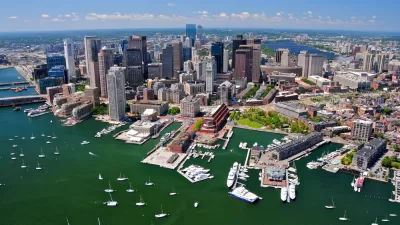Two icehouses have arrived in Harrisburg on a mission from the Central Pennsylvania chapter of the U.S. Green Building Council.

Laura Legere reports on a creative demonstration of the power of innovative building practices taking place on the steps of the Pennsylvania State Capitol.
There, green building advocates have placed two eight-foot-by-eight-foot sheds filled with blocks of ice. Legere explains in more detail:
The icehouse on the left meets Pennsylvania’s energy code requirements, which have not been updated since 2009. The one on the right is super-insulated and tightly sealed to meet passive house standards, an energy efficiency benchmark that surpasses even the most modern building codes.
It should only take three weeks to reveal the differences between the two sheds, and the idea behind the demonstration is to "inspire lawmakers to update the state’s energy conservation building codes and reform the process for adopting new code."
The state has a mandate to update its model international standards every three years, according to Legere.
The Senate and House have each passed bills this spring designed to revise the state’s building code adoption process, which has largely stalled since a 2011 law required an advisory board to approve each code change with a two-thirds vote and made it cumbersome to catch up with past standards.
The Central Pennsylvania chapter of the U.S. Green Building Council has organized and promoted the event along with partners. The chapter has provided more information on the demonstration with a press release on June 6, 2017, otherwise known as "Icehouse Demonstration Day."
FULL STORY: Melting ice on Pa. Capitol steps builds case for green building codes

Maui's Vacation Rental Debate Turns Ugly
Verbal attacks, misinformation campaigns and fistfights plague a high-stakes debate to convert thousands of vacation rentals into long-term housing.

Planetizen Federal Action Tracker
A weekly monitor of how Trump’s orders and actions are impacting planners and planning in America.

In Urban Planning, AI Prompting Could be the New Design Thinking
Creativity has long been key to great urban design. What if we see AI as our new creative partner?

Massachusetts Budget Helps Close MBTA Budget Gap
The budget signed by Gov. Maura Healey includes $470 million in MBTA funding for the next fiscal year.

Milwaukee Launches Vision Zero Plan
Seven years after the city signed its Complete Streets Policy, the city is doubling down on its efforts to eliminate traffic deaths.

Portland Raises Parking Fees to Pay for Street Maintenance
The city is struggling to bridge a massive budget gap at the Bureau of Transportation, which largely depleted its reserves during the Civd-19 pandemic.
Urban Design for Planners 1: Software Tools
This six-course series explores essential urban design concepts using open source software and equips planners with the tools they need to participate fully in the urban design process.
Planning for Universal Design
Learn the tools for implementing Universal Design in planning regulations.
Gallatin County Department of Planning & Community Development
Heyer Gruel & Associates PA
JM Goldson LLC
City of Camden Redevelopment Agency
City of Astoria
Transportation Research & Education Center (TREC) at Portland State University
Jefferson Parish Government
Camden Redevelopment Agency
City of Claremont





























